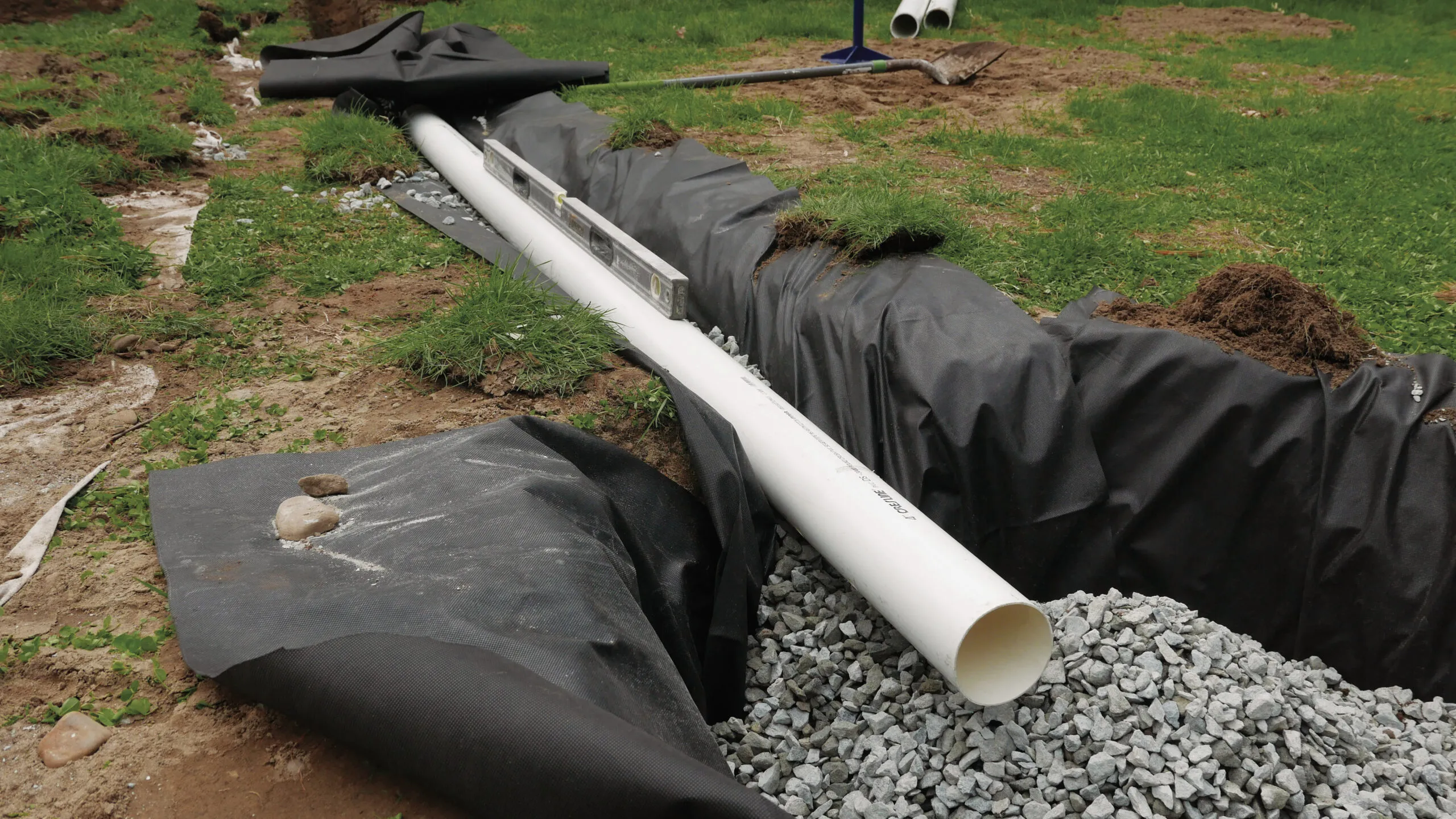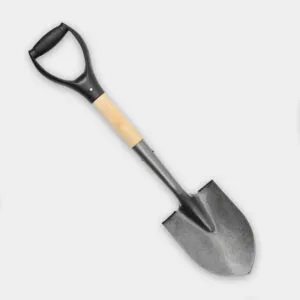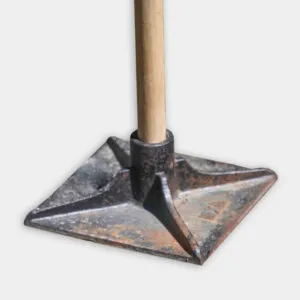We may be compensated if you purchase through links on our website. Our team is committed to delivering honest, objective, and independent reviews on home products and services.
Project details
Skill
Cost
Estimated Time

“Our backyard slopes down to a swale that floods completely after heavy rains or snow thaws. A sump pump and downspout also discharge water into the swale. What’s the best way to get rid of this excess water, or at least control it?”—JAKE GITTLESON, AURORA, IL
A dry well is a management system for excess water on your property, especially in areas prone to flooding or with poor drainage. This structure is a lined hole in the ground that collects and slowly releases water into the surrounding soil, preventing it from backing up and ruining your foundation. Not only does it prevent flooding, but you can also save money on your water bill by managing water waste. In this guide, This Old House expert Mark McCullough works with homeowner Chris to build a simple dry well in his backyard.
What is a Dry Well?
A dry well is a large hole in the ground filled with gravel or stone that temporarily holds water and allows it to percolate into the surrounding soil. This system is handy for managing water from downspouts, sump pumps, and other sources of extra water on your property.
How Deep Should a Dry Well Be?
The depth of a dry well depends on many factors, including soil type and water volume. Generally, a dry well should be at least 3 to 4 feet deep. In the video, McCullough digs a dry well approximately 4 feet in diameter and 3 feet deep, which works for most residential projects.
Capacity of a Dry Well
The capacity of a dry well varies based on its size and the surrounding soil’s ability to absorb water. A typical residential dry well can hold several hundred gallons of water. However, the exact capacity depends on the dimensions of the well and the void space between the stones used to fill it.
Benefits of a Dry Well
Dry wells offer several benefits for homeowners, primarily aimed at protecting your home and yard from potential water damage:
- Prevent water pooling near the foundation
- Reduce soil erosion
- Increase groundwater recharge
- Improve how your landscape’s appearance and health by preventing soggy spots
Materials and Tools Needed for Dry Well Installation
Before starting your dry well project, be sure you have all the equipment you need for a smooth installation with no interruptions.
- Crushed stone (3/4-inch)
- Landscape fabric
- PVC pipe (solid and perforated)
- PVC couplings and elbows
- PVC glue
- Shovel
- Wheelbarrow
- Hand tamper
- Level
- Utility knife
Steps to Build a Simple Dry Well
Follow these steps carefully to construct your dry well so that the system is properly installed and works like a charm:

- Call the local utility locating service to mark any underground utilities.
- Determine the location for your dry well and lay out the PVC pipe route.
- Cut and remove the grass along the pipe route and dry well location. The solid pipe will go closest to the house, and the perforated pipe will go closest to the dry well.
- Use the shovel to cut into the soil just underneath the grass and move the top layer to a tarp. That way, the grass can be put back in place once the trench is dug.
- Dig a trench for the PVC pipe, approximately 8-10 inches deep.
- As the trench gets closer to the dry well, make the trench slightly deeper and slightly wider to ensure no water leeches back towards the house.
- Excavate the dry well hole, about 4 feet in diameter and 3 feet deep.
- Line the bottom and sides of the dry well with landscape fabric.
- Line the trench with landscape fabric up to where the perforated pipe will start.
- Fill the dry well with crushed stone, tamping down each layer with a hand tamper. Repeat this process until the hole is filled to the level of the trench.
- Add a thin layer of crushed stone to the trench.
- Connect the PVC pipes using couplings and PVC glue. Use the elbow to connect a vertical piece to catch the rainwater from the gutter.
- Place the connected pipes in the trench, making sure they are properly sloped.
- Fill the trench and hole with the remaining crushed stone, leaving just enough room at the top for the layer of grass.
- Fold the landscape fabric over the top of the crushed stone.
- Backfill with soil and replace the grass.
Proper Dry Well Installation Techniques
Make sure your system is correctly installed so that it drains properly and you avoid damaging your home or yard.
Slope and Drainage
Keep a proper slope in your pipe system for efficient water flow and to prevent the water from stagnating. McCullough recommends a slope of 1/4 inch per foot, which provides enough pitch for water to drain into the dry well. Use a level to check the slope as you install the pipes.
Pipe Connections
When connecting PVC pipes, use the right couplings and PVC glue to create watertight seals. This prevents water from leaking into the surrounding soil before reaching the dry well. Use a cap with a smaller opening to keep debris out of the system for downspout connections. Properly sealed connections keep the water flowing directly into the dry well, making the system more efficient.
Landscape Fabric Usage
Landscape fabric is an extra barrier that prevents soil from infiltrating the crushed stone and clogging the system. McCullough makes sure that the fabric completely lines the dry well and trench, with enough excess to fold over the top of the crushed stone before backfilling.
Additional Dry Well Tips and Considerations
Read these extra tips and suggestions for a professional-looking and robust installation.
Choose the Right Location
Place the dry well at least 10 feet away from your home’s foundation to prevent water from seeping back toward the house. Additionally, choose an area where water naturally accumulates so the well is most efficient. Avoid low spots near your home’s foundation that might worsen your water problems.
Seasonal Maintenance
Regular maintenance of your dry well system will ensure its longevity and effectiveness. Inspect gutters and downspouts for debris, especially during fall and spring. Clean these components to prevent clogs and ensure optimal water flow.
Find and Fix Clogs
If you notice slow drainage or water pooling around the dry well, it may be clogged with sediment or debris. Use a sewer snake or water jet to clear the pipes and get it working again. Make sure to fix any clogs immediately so you don’t damage your well.
Improve Your Landscaping
Dry wells can sometimes be an eyesore in your yard. To blend the dry well into your garden, include landscaping elements such as plants or mulch. This will help you manage water effectively and keep the yard looking nice.
Dry Well Maintenance and Longevity
Explore the suggestions below to keep your well collecting and draining properly:
- Regularly inspect and clean gutters and downspouts to prevent gunk from clogging the system up.
- Periodically check the area around the dry well for signs of water pooling, which may indicate the need for maintenance.
- Install a catch basin or filter at the entrance of the pipe system to catch debris before it falls into the dry well.
- Check the condition of the landscape fabric and replace it if you see wear or damage.
Alternative Solutions
A dry well may not be a good solution for every property, so we’ve listed some alternatives for you to consider. Each solution offers unique benefits and can fit different landscaping and drainage needs. Consult with a landscaping professional to find the best solution for your yard.
- Rainwater harvesting systems: These systems capture and store rainwater for later use, reducing the amount of runoff.
- French drains: These are gravel-filled trenches with perforated pipes that redirect surface and groundwater away from an area.
- Rain gardens: These are shallow depressions planted with native vegetation that absorb rainwater runoff.
- Permeable pavers: These pavers allow water to seep through and into the ground, reducing runoff and promoting groundwater recharge.



